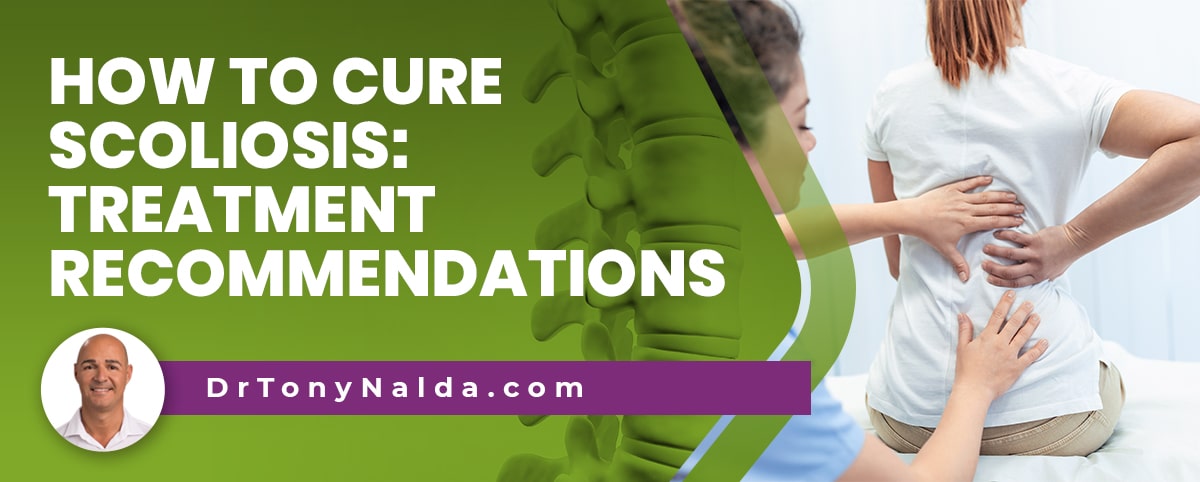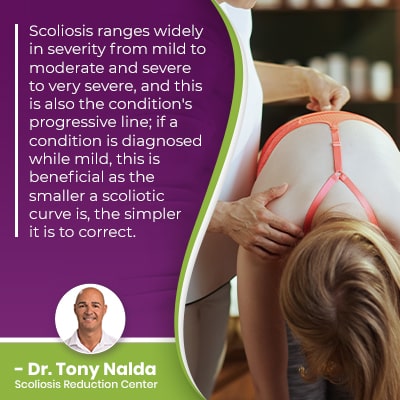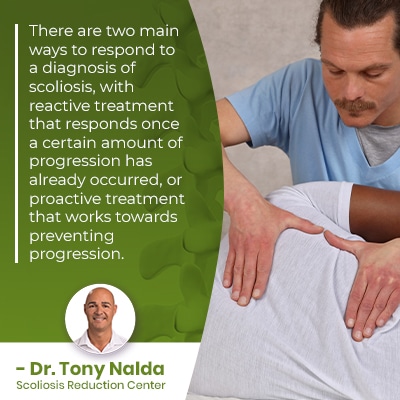How To Cure Scoliosis: Treatment Recommendations

Scoliosis is a progressive condition, and that means its nature is to get worse over time, so where a scoliosis is at the time of diagnosis isn't indicative of where it will stay; only proactive treatment can successfully counteract the condition's progressive nature. Continue reading to learn the difference between a reactive and a proactive scoliosis treatment response.
To be clear, as a progressive condition, there is no curing scoliosis, but it can be highly treatable. The best way to minimize the condition's effects is through proactive treatment that impacts scoliosis on a structural level.
Treating scoliosis starts with a diagnosis, so let's explore the parameters that have to be met in order to reach a diagnosis of scoliosis.
Table of Contents
Reaching a Diagnosis of Scoliosis
While there are never treatment guarantees, scoliosis diagnosed early in the condition's progressive line can mean early intervention, if a proactive treatment response is chosen.
To be clear, however, there is no curing scoliosis, but it can be highly responsive to treatment and managed effectively.
Scoliosis involves the development of an unnatural sideways spinal curve that also twists, and as a progressive condition, the size of the unnatural spinal curve is virtually guaranteed to increase over time.
Early detection means a condition is diagnosed before significant progression has occurred.
 Scoliosis ranges widely in severity from mild to moderate and severe to very severe, and this is also the condition's progressive line; if a condition is diagnosed while mild, this is beneficial as the smaller a scoliotic curve is, the simpler it is to correct.
Scoliosis ranges widely in severity from mild to moderate and severe to very severe, and this is also the condition's progressive line; if a condition is diagnosed while mild, this is beneficial as the smaller a scoliotic curve is, the simpler it is to correct.
Scoliosis severity is determined by a measurement known as Cobb angle, and this is a key piece of information that treatment plans are shaped around:
- Mild scoliosis: Cobb angle measurement of between 10 and 25 degrees
- Moderate scoliosis: Cobb angle measurement of between 25 and 40 degrees
- Severe scoliosis: Cobb angle measurement of 40+ degrees
- Very-severe scoliosis: Cobb angle measurement of 80+ degrees
The more severe a condition, the further out of alignment the spine is, and the more likely it is that the condition's effects are going to be noticeable.
The main effect of scoliosis in children is postural deviation, and this is due to the condition's uneven forces disrupting the body's overall symmetry.
Oftentimes, the condition's earliest telltale signs in children are uneven shoulders and hips, and in adults, the main effect is pain, and this is because scoliosis becomes a compressive condition once skeletal maturity has been reached.
When it comes to treating scoliosis, the type is important because different forms of scoliosis have different treatment needs.
Treatment and Condition Type
In addition to ranging so widely in severity, there are also different types of scoliosis, which is why no two cases are the same, nor will two treatment plans be the same; the complex nature of the condition necessitates the fully customization of treatment plans.
Approximately 80 percent of known diagnosed scoliosis cases are classified as idiopathic scoliosis, and the remaining 20 percent are associated with known causes: neuromuscular scoliosis, degenerative scoliosis, and congenital scoliosis.
The most prevalent form of scoliosis overall is adolescent idiopathic scoliosis, diagnosed between the ages of 10 and 18.
Neuromuscular scoliosis patients have a larger neuromuscular condition causing the development of their scoliosis as a related complication, so treatment options for neuromuscular scoliosis are different than in more typical forms as the larger neuromuscular condition (cerebral palsy, spina bifida, muscular dystrophy) is the focus of treatment.
Degenerative scoliosis patients need treatment that preserves spinal health and function, while focusing on achieving better support and stabilization for the spine.
Congenital scoliosis is a rare form affecting approximately 1 in 10,000 and is caused by a malformed spine that develops in utero, so a treatment plan for congenital scoliosis is going to need a lot of modification to address the unique challenges of treatments for scoliosis in such young patients.
In typical forms of idiopathic scoliosis, the scoliotic curve bends to the right, away from the heart, but in atypical forms, such as neuromuscular and congenital scoliosis, the curve can bend to the left towards the heart; when I see a left-bending curve, this is a red flag that there is an underlying pathology causing the scoliosis.
Now when it comes to treatment for idiopathic scoliosis, as this is the type of scoliosis that is most prevalent and affects all ages, let's focus our discussion on how to treat idiopathic scoliosis with conservative treatment.
Nonsurgical Treatment for Idiopathic Scoliosis
There are two main ways to respond to a diagnosis of scoliosis, with reactive treatment that responds once a certain amount of progression has already occurred, or proactive treatment that works towards preventing progression.
Traditional treatment commonly funnels patients towards spinal fusion surgery because of a reactive approach, while modern conservative treatment offers a proactive non-surgical treatment response.
When it comes to surgical procedures performed on the spine, these can be risky and invasive, and the reality is that many cases of scoliosis don't need surgical intervention, and curve progression can be managed effectively with chiropractic-centered treatment.
When it comes to treating adolescent idiopathic scoliosis, the condition's most-prevalent form, this age group is the most at risk for rapid-phase progression because although we don't fully understand what causes idiopathic scoliosis to develop initially, we do know that it's growth that causes it to progress.
Having an abnormal curvature of the spine means the body is being exposed to a lot of uneven forces, and it's the goal of treatment to reduce those uneven forces, and the best way to achieve that is to impact the condition on a structural level.
As a structural spinal condition, scoliosis involves an abnormality within the spine itself, so in order to be addressed effectively, it has to be primarily impacted on a structural level.
Here at the Scoliosis Reduction Center, I work towards correcting scoliosis by combining multiple scoliosis-specific disciplines into treatment plans for the best results.
Chiropractic Care
 Chiropractic care is how I work towards impacting the condition on a structural level; I apply a series of techniques and manual adjustments to adjust the position of the curve's most-tilted vertebrae back into alignment with the rest of the spine.
Chiropractic care is how I work towards impacting the condition on a structural level; I apply a series of techniques and manual adjustments to adjust the position of the curve's most-tilted vertebrae back into alignment with the rest of the spine.
Once I start to see structural results, I can shift my focus to other areas of treatment for scoliosis.
Physical Therapy
A combination of physical therapy and scoliosis-specific exercises (SSEs) is a valuable facet of treatment.
Increasing core strength means the spine is optimally supported and stabilized by its surrounding muscles, and physical therapy and exercise treatment can also help improve posture, balance unbalanced muscles, and stimulate certain areas of the brain for enhanced brain-body communication.
Corrective Bracing
Here at the Center, I rely on corrective bracing when treating childhood scoliosis as bracing can be particularly effective on growing spines.
I favor the ultra-corrective ScoliBrace because it can help augment corrective treatment results by pushing the spine into a corrective position.
Rehabilitation
Again, as a progressive condition, there is no curing scoliosis, so continued effort needs to be made to hold treatment results, and this can include leading a scoliosis-friendly lifestyle.
Continued chiropractic care can help sustain a curvature reduction, and a series of prescribed exercises can help patients establish a home-rehabilitation program for further stabilizing and healing the spine.
Conclusion
So when it comes to scoliosis treatment options, there is no way to cure scoliosis in the sense of permanently fixing the condition, and this is because scoliosis is a progressive condition.
Progressive conditions are virtually guaranteed to worsen over time, which is why starting treatment sooner, rather than later, is always the best choice.
The two main scoliosis treatment options are traditional and conservative treatment, and traditional treatment commonly involves spinal surgery, while conservative treatment offers an alternative to scoliosis surgery.
Conservative treatment is considered proactive because it starts treatment as close to the time of diagnosis as possible; this is because waiting is wasting valuable treatment time and can amount to allowing a scoliotic curve to progress unimpeded.
Scoliosis progressing makes it more complex to treat; the curve will be larger, the body will have had ample time to adjust to the unnatural curvature of the spine, and the condition's effects will be established.
For those who develop scoliosis, it's important to understand that scoliosis curves can get worse, and a spinal curvature that's left untreated is virtually guaranteed to do so.
All types and severity levels of scoliosis require treatment, so why not start early in the condition's progressive line when treatment success is going to be the most likely?
Dr. Tony Nalda
DOCTOR OF CHIROPRACTIC
After receiving an undergraduate degree in psychology and his Doctorate of Chiropractic from Life University, Dr. Nalda settled in Celebration, Florida and proceeded to build one of Central Florida’s most successful chiropractic clinics.
His experience with patients suffering from scoliosis, and the confusion and frustration they faced, led him to seek a specialty in scoliosis care. In 2006 he completed his Intensive Care Certification from CLEAR Institute, a leading scoliosis educational and certification center.
About Dr. Tony Nalda
 Ready to explore scoliosis treatment? Contact Us Now
Ready to explore scoliosis treatment? Contact Us Now





